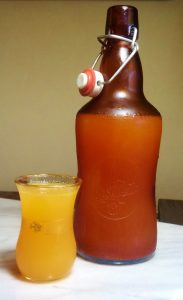 Loaded with minerals, probiotics, and phytonutrients called betalains, Orange Ginger Beet Kvass is a serious contender in my Top 5 Best-Health-Foods-Ever list and could be the most potent fermented food I have discovered.
Loaded with minerals, probiotics, and phytonutrients called betalains, Orange Ginger Beet Kvass is a serious contender in my Top 5 Best-Health-Foods-Ever list and could be the most potent fermented food I have discovered.
Lisa’s Counter Culture book provides the best beet kvass recipe I have found; it’s the one I use at home and is provided below with minor improvements. I prefer using crimson beets for the flavor and for the stronger benefit. I found Chiogga beets to have the least appealing flavor and weakest benefit.
Beet kvass’ complex flavor profile of sour, salty, sweet, and umami is not often found in the modern American diet. While it is not a beverage you are likely to share with house guests, beet kvass holds a prominent place in my home.
Many recipes call for adding whey, but I believe it is worth avoiding whey for several reasons:
- The end product is more palatable and tastier without using whey.
- Whey is used to shorten fermentation times (i.e., as a short-cut), which prevents the probiotic strains naturally occurring in the beets from culturing through their full cycle, thus diminishing nutritional value and probiotic content (a minimum of 3 weeks is required for “wild” fermentation).
- Whey has probiotic strains specific to its source: dairy. Beets and other vegetables have different strains of probiotics; consumption of a variety of probiotic strains is recommended for maximum health benefit.
- You don’t need whey to make fermented foods, especially if you are allergic to dairy.
Ingredients
6 medium-sized beets, scrubbed and roughly chopped, enough to fill the fermentation jar ½ full
2″ knob of ginger, grated
2% brine, about 19 g of sea salt per quart of water, or 3 tbsp of sea salt in 2+ quarts of water total
1 organic orange, juiced and zested, for the second ferment
Equipment
1-gallon fermentation jar with airlock (available online from Cultures for Health or Pick-It)
Flip top bottles, e.g., 4 22-oz Fischer Beer bottles
Directions
- Clean and sanitize kitchen surfaces; the cleaner your environment the better. Clean and sanitize the equipment (fermentation jar, weights) to ensure the absence of pathogenic bacteria. Be sure to rinse off the equipment after sanitizing it so does not kill the beneficial bacteria needed for fermentation.
- After cutting the tops and spindly roots off of the beets, scrub with skins under cold water. Chop beets into ½” to 1” cubes and place in the 1-gallon fermentation jar along with the grated ginger.
- Cover chopped beets and ginger with 2% brine, leaving 1” airspace. Dissolve 3 tbsp of sea salt in one cup of boiled water separately; dilute and cool in a quart of water. Add brine to the fermentation jar and add additional fresh water to fill 1” from the top.
- Fill the airlock half way with water and seal the jar tightly.
- Place in a location between 68-72 degrees F and away from direct sunlight. Forget about it for at least 3 weeks, preferably 4 weeks. Beet kvass can ferment up to 6 weeks if desired.
- After 3 to 4 weeks, it’s time for the second ferment. Add the orange zest and juice, seal the jar tightly, and leave for another 2-5 days (to taste).
- Pour off the beet kvass into flip top bottles and enjoy!